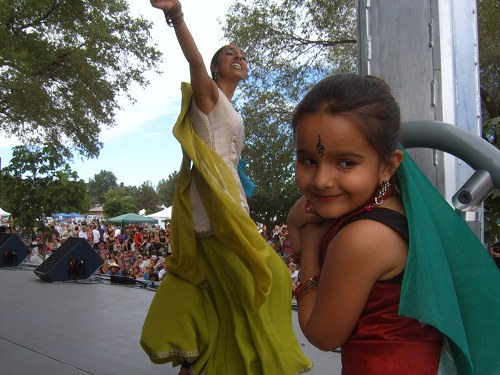Mudra Dance Studio has been celebrating the dynamic traditions of classical Indian dance, and putting a contemporary spin on it, since long before Bollywood films became a popular genre here in the US with non-Indians. Namita Khanna Nariani, a brilliant, energetic dynamo of a teacher and choreographer, founded the troupe 17 years ago and turned it into a non-profit organization eight years ago — all while raising a family and maintaining a career as an architect.
We first met Namita in the second year of the Colorado Dragon Boat Festival (the photo above is from this summer’s festival), and she’s been a regular every year since, closing out the festival with a one-two punch of her Mudras followed by the very popular Denver Taiko Japanese drummers. Starting the third year, at Erin’s suggestion, the Mudras started collaborating with Denver Taiko and now that’s become a regular cross-cultural highlight of the event.
The powerful Japanese drums have come to fit so well in Namita’s South Asian vision of cultural fusion, in fact, that Mudra Dance Studio now incorporates a taiko drummer, Thomas Knight, as a regular part of its exciting annual performances.
 This year’s performance, ILLham, opens this Sunday at 2 pm, and then repeats Saturday, Nov. 20 at 5 pm and Sunday, Nov 21 at 2 pm, at the Lakewood Cultural Center. Tickets are available online at the Mudra website.
This year’s performance, ILLham, opens this Sunday at 2 pm, and then repeats Saturday, Nov. 20 at 5 pm and Sunday, Nov 21 at 2 pm, at the Lakewood Cultural Center. Tickets are available online at the Mudra website.
Each of the annual Mudra shows are carefully structured to be showcases not only of fabulous dance, music and multimedia, but also of an innate spirituality that is a part of the Mudra lifestyle. All its members seem imbued with this spirituality, because it flows down from Nariani herself. She explains the idea of ILLhaam, which is about cycles:
Continue reading






 Jamal’s devotion to Latika, even though they’re repeatedly separated, sometimes for years, and his dedication to finding her again, is the film’s narrative thread.
Jamal’s devotion to Latika, even though they’re repeatedly separated, sometimes for years, and his dedication to finding her again, is the film’s narrative thread. 





